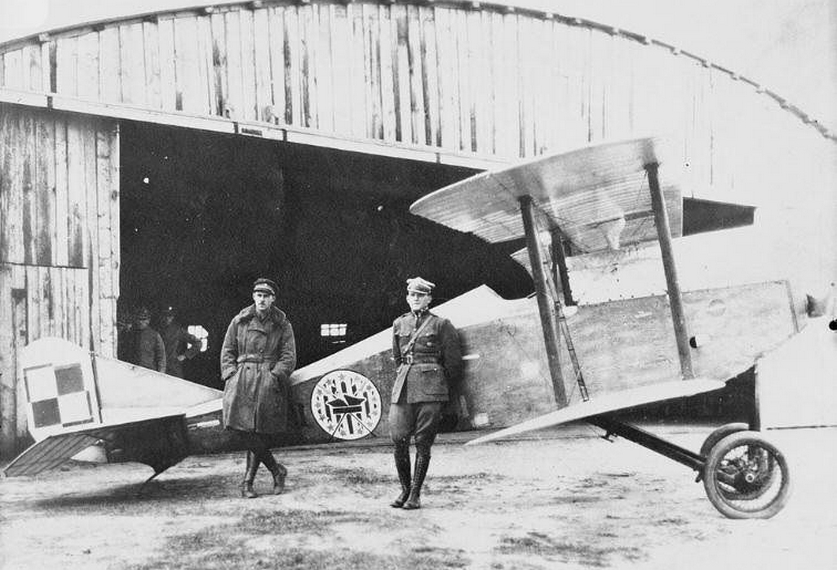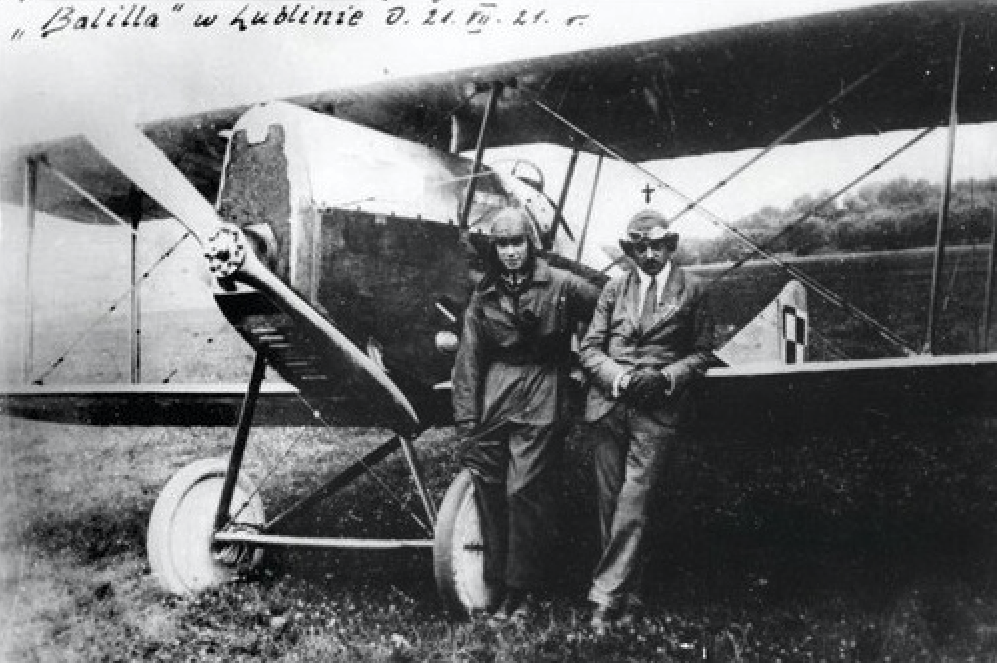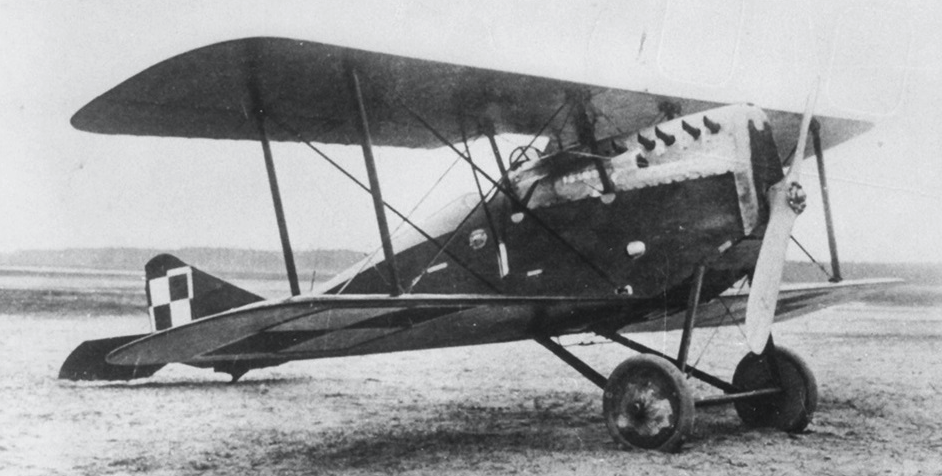Kraków 2017-12-30
History
00120b Section 1920 year.
Ansaldo A-1 Balilla in Poland.



In the spring of 1917, during the Great World War, an Ansaldo A-1 Balilla fighter plane was built at the Ansaldo plant in Turin. Some sources incorrectly give the city of Genoa the origin. It must be remembered that the Ansaldo concern operated mainly in the shipbuilding industry and had the largest shipyard in Genoa. On the other hand, planes and cars were built in Turin. The constructor of the Ansaldo A-1 Balilla was Eng. Giuseppe Brezzi.
The plane was basically a continuation of the manufacturer's aircraft line and was a direct development of the Ansaldo SVA-5 aircraft. The plane had smaller dimensions and was single-seater. Work on the plane took a relatively long time. The prototype was completed in the summer of 1917. The exact date of the flight is unknown, as numerous modifications were made several times. The test taker was the factory pilot Mario Stoppani.
The Ansaldo A-1 Balilla is a typical biplane of the Great World War. It is almost entirely made of wood. The hull is wooden, and it is made similar to simple fishing boats. The hull consists of several frames, stringers and plywood cladding about 2 mm thick. The front part of the fuselage has a rectangular cross-section, and the rear part is triangular, with the base at the top and the tip at the bottom. This is a typical feature of SVA aircraft. This arrangement was intended to ensure good downward visibility to the rear. The front wooden frame held the engine mount. The entire front part of the fuselage was covered with aluminum sheet.
6-cylinder, in-line, liquid-cooled engine. It was relatively heavy. To reduce the plane's cross-section, an engine radiator was placed in front of the engine. The engine moved a two-bladed, fixed, wood-frame propeller.
The rectangular, double-girder panels, covered with canvas, are connected with two pairs of steel tube posts and stiffened with steel ties.
The plane reached the horizontal speed and rate of climb intended by the constructors. But it turned out not to be maneuverable. It came easily into the corkscrew and it was difficult to get it out of it. In December 1917, the plane was tested by many excellent Italian pilots. Their opinions confirmed the ratings of the factory pilots. The wingspan has been slightly increased. By the way, a newer, more powerful engine, designated SPA-6A, with 220 HP (162 kW) was installed. The shape of the radiator grille was also changed.
In March 1918, the plane was handed over to the military for the purpose of combat testing. The aircraft was assessed positively, although engine failures were frequent. In May 1918, the plane was put into mass production, although it was slower than planned. At the end of May 1918, the planes were already handed over to various Italian combat units. The order for Ansaldo A-1 Balilla planes was 1,600, but by the end of the war about 220 were built and another 110 after the war.
The plane was named Balilla. It was the nickname of the Italian national hero Giovan Battista Perasso, who in 1746, as a boy, threw stones at an Austrian patrol.
Ansaldo A-1 Balilla users: Italy, Poland, Argentina, Spain, Latvia, Uruguay, Soviet Russia.
Ansaldo A-1 Balilla in Poland.
In 1919, Poland bought from the Italian company Ansaldo in Turin three types of aircraft necessary for the reborn Polish Army. These were A-300 intelligence-bombing aircraft (30 pieces + license), SVA-5 / -9 / -10 surveillance aircraft (80 pieces) and A-1 Balilla fighter aircraft (35 pieces + license).
Ansaldo A-1 Balilla aircraft were purchased at one time, 35 pieces, without weapons. At the same time, a license for their production was purchased. The delivery of the planes was to be carried out by March 10, 1920, but due to organizational difficulties with transport, it was delayed until August 1921.
It was decided to bring two planes to Poland by air, taking off from Turin. The first was Ansaldo A-300 with the crew of Ludomił Rayski and Witold Rumbowicz. The second was Ansaldo A-1 Balilla with pilot Stefan Pawlikowski. The flight was partially successful. The Ansaldo A-300 reached Pole Mokotowskie without any problems, via France and Germany. The second, Ansaldo A-1 Balilla, ended the flight in France due to an engine failure. With the help of the Polish Military Mission in France, the plane traveled from France to Poland by sea. The plane was renamed "Prim". In February 1920, this aircraft took part in an air rally in which it competed with RAF SE-5a and Fokker D-VII aircraft.
The first batch of 15 Ansaldo A.1 Balilla aircraft was delivered to Poland by sea on January 9, 1920 to Gdańsk, from where they were delivered by rail to Warsaw. After assembling at the Central Aviation Workshop, it was received on May 26, 1920 by the 7th Fighter Squadron. Tadeusz Kościuszko, stationed at the time at the frontline airport Biała Cerkiew. There were 12 Balilla planes in this squadron. Ansaldo A-1 Balilla devices, along with Oeffag D-III planes, took part in the final phase of the Kiev offensive. The pilots of the 7th Kościuszko Squadron, until the truce in October 1920, fought on these planes on the Galician Front in the Polish-Bolshevik war, primarily performing missions against ground targets. After the war, the 7th Fighter Squadron was stationed in Lviv, and in May 1921 it was included in the 1st Aviation Regiment in Warsaw.
The second batch, 10 Ansaldo A-1 Balilla aircraft, arrived in Poland in the summer of 1920. The last batch of 10 fighters reached Krakow in August 1921, probably by rail. First of all, they were used for training flights.
Production of Ansaldo A-1 Balilla in Poland.
The rebirth of the Republic of Poland opened up new opportunities for the Emil Plage and Teofil Laśkiewicz Mechanical Works in Lublin. Teofil Laśkiewicz, at the urging of eng. Arciszewski, asked the air force inspector for permission to establish an aviation department. A positive response came on February 14, 1920. On February 17, 1920, the plant signed an agreement with the Military Aviation (Main Army Supply Office) for production, under the license of Italian aircraft; fighter Ansaldo A-1 Balilla (200 pieces) and reconnaissance bomber Ansaldo A-300 (100 pieces). The contract was for a total of 300 units.
More land was purchased for the new production halls. The area of the plant increased from slightly more than 1 ha to 13-14 ha. There is 10,000 m2 under the roof. In 1921, the factory employed about 500 people. Address; Lublin, Fabryczna 26 Street (Bronowice district).
The first Ansaldo A-300 was flown on June 15, 1921. According to a common opinion, popularized during the People's Republic of Poland, the quality of the aircraft was low. There have been several disasters. There were cracks in the spars and the flaps falling off. The plane was difficult to recover from the spin. This resulted in a reduction in the order. In individual years they were built; 1921 - 14 machines, 1922 - 22 machines, 1923 - 60 machines, 1924 - until the production of 36 machines is stopped. The list also includes Ansaldo A-300 aircraft.
In the period 1920-1924, 57 (70) Ansaldo A-1 Balilla aircraft were built in Lublin. A total of 92 (105) Ansaldo A-1 Balilla planes were used by the Polish Army.
The fact is; that in July 1921, the ace of world aviation, pilot Adam Haber-Włyński, died during the evolution. In 1922, as a result of wing tearing off, the following people died in the Ansaldo A-300 plane: Józef Ryba and the military controller senior mechanic Wiktor Górski.
Each accident, and especially a fatal one, was subject to careful analysis, and as a result, there were delays in the production and acceptance of aircraft for the Polish Army.
The biggest problem, however, was the engines. Their cooling system was inefficient. The pistons in the cylinders and the bearings on the crankshaft seized. As a result, the engine stopped working and even a fire broke out. There was an opinion that Italians supplied engines to Poland after repairs, and not new or older, less powerful engines.
At the end of May 1923, a static test was carried out on two serial airframes taken from production, which gave a positive result. The strength factor was 13.5, compared to the required 8. In June 1923, the wings and fuselage were inspected, which showed defects in their construction.
In May and June 1924, several articles attacking the Lublin plant appeared in the press. As a result, an investigation was conducted and a report compiled which states that out of 110 planes, 18 were injured, but only one was the plant's fault. The blame must be placed on the poor and faulty Italian engines. The Italian airframes themselves had design flaws. They were adapted to operation in a dry climate and had no protection against moisture. The adhesives used were not resistant to high humidity and low temperatures that occur in Poland, which was initially not taken into account. As a result, Lublin planes did not enjoy a good reputation.
This report contributed to the fact that in 1924, the plants received an order for the licensed production of French Potez XV line planes, of which 100 were produced between 1925 and 1926. Subsequently, the plants were commissioned to license production of Potez XXV line planes, of which 150 were produced in 1928 - 1931. Both types were produced simultaneously in Lublin and Biała Podlaska at the PWS - Podlaska Wytwórnia Samolotów plant. In the period 1929 - 1930, the plant produced, under the license of Fokker, 11 Fokker F-VIIB / 3m passenger planes and another 20 in independently developed bomb and landing versions.
Was the Ansaldo A-1 Balilla aircraft difficult to fly? He certainly required an experienced pilot, which was confirmed by the actions of the Kościuszko Squadron defeating the cavalry of the illiterate Budyonny. All the squadron pilots were experienced pilots. They were able to use the advantages of the plane in combat. Certainly, due to the heavy engine, the plane had a high load on the lifting surface. He was not suitable for acrobatics, especially on small ceilings. It was impossible to put it sharply on the wing at too low speed. However, it was less sensitive to gusts of wind.
Ansaldo A-1 Balilla planes were used in the 2nd Aviation Regiment in Kraków until 1925, the 1st Aviation Regiment in Pole Mokotowskie until 1926, and until 1927 they were used in the 11th Aviation Regiment in Lida. The planes were also operated at the Pilot's School in Bydgoszcz and at the Higher School of Pilots in Grudziądz. On June 10, 1927, the last flight accident at Ansaldo A-1 Balilla in the League was recorded, in which the pilot was killed. After this accident, all other planes were decommissioned and canceled. In total, five pilots died on the Ansaldo A-1 Balilla aircraft. According to other data, as many as 15 pilots died.
The greatest material loss was a hangar fire at Rakowice-Czyżyny Airport in which five Ansaldo A-1 Balilla planes were lost.
Airframe Ansaldo A-1 Balilla.
Fighter, single-seat, single-engine, biplane, wooden structure, open cabin and fixed landing gear.
Double-girder wings with canvas cover. Concave-convex leaf profile. Stands made of steel pipes with a drop cross-section and additionally stiffened with wire were mounted between the panels.
The fuselage of the aircraft is of a wooden frame and stringer structure, covered with plywood, and sheet metal in the vicinity of the engine. Triangular cross-section of the hull, similar to that of A.1 "Balilla". A chassis with a split axle (two-axle), additionally stiffened with "V" -based struts. Shock absorption with a rubber cord, and the tail skid made of a half-spring.
SPA 6A engine with 220 HP (164 kW). Front cooler, as in Ansaldo A-300. Four fuel tanks: main and one auxiliary in the fuselage, and the other two rainwater tanks located in the middle of the upper lobe. 1 × SPA 6A in-line 6-cylinder engine, 164 kW (220 hp).
Armament of Ansaldo A-1 Balilla: two 7.70 mm Vickers machine guns, fixed, synchronized with the rotation of the propeller, mounted on both sides of the engine, hidden under the engine cover.
Details of T-T Ansaldo A-1 Balilla:
Wingspan 7.68 m (25 ft 2 in). Length 6.84 m (22 ft 5 in). Height 2.53 m (8 ft 4 in). Wing area 21.20 square meters (228 ft2). Curb weight 625 - 640 kg (1.410 lb). Take-off weight 870 - 885 kg (1,950 lb). Top speed 220 km / h (140 mph). Rate of climb 6.3 m / s. Service ceiling 5,000 m (16,400 ft). Range 525 - 660 km (410 miles).
Tally
In the period 1920-1924, 57 (70) Ansaldo A-1 Balilla aircraft were built in Lublin. In total, there were 92 (105) aircraft in the Polish Army.
Written by Karol Placha Hetman
